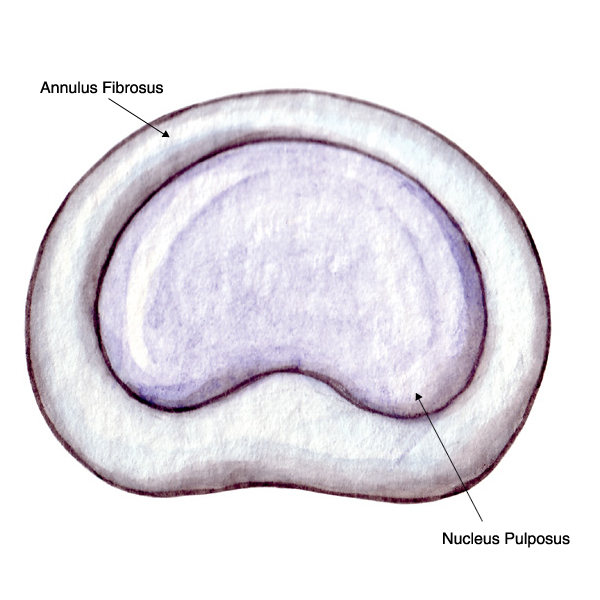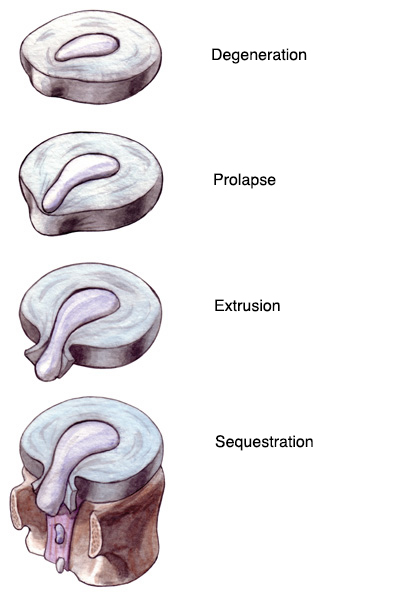As we age, changes in our physiology and “wear and tear” can affect our spine. Particularly vulnerable to age-related degeneration are the discs or little cushions that separate the vertebrae and act as shock absorbers. These discs act as spacers between the vertebra bones and help the bones of the spine deal with the pressures of walking, running, and movement. They accomplish this because they are filled with a jelly-like substance called nucleus pulposus in a very rugged disc-shaped casing.

Degenerative disc disease (DDD) is a general term used to describe these degenerative and often age-related changes in the discs. Technically, DDD is a syndrome and not a true “disease.”
Discs serve a valuable and unique purpose in the body, but if they are damaged, rupture, become brittle or misshapen, they lack the ability to repair themselves. People with DDD have discs that may become:
- Dried out (less fluid inside and less ability to absorb shock)
- Flattened (providing less spacing)
- Stiff (less cushioning power)
- Bulging out or otherwise misshapen
- Broken open (ruptured or herniated)
In some cases of DDD, the nucleus pulposus inside the disc can leak out. If this substance comes in contact with nearby nerves, it can irritate them and cause considerable pain. Since the spinal column is the “nerve center” of the body, ruptured discs are very likely to irritate nearby nerves.

Causes of Degenerative Disc Disease
By far the most common cause of degenerative disc disease is aging. Even if there is no direct damage to the disc, the stiffening and wear of tissue in all parts of the body can cause sufficient stress on the disc to cause it to flatten or microscopic tears to occur. Degenerative disc disease can also occur in response to repetitive stress on the spine.
Symptoms of Degenerative Disc Disease
Degenerative disc disease may be challenging to diagnose at first because the symptoms may come on gradually and be dismissed at first, particularly in seniors who accept some “aches and pains” as a normal part of growing older.
The pain of degenerative disc disease may be mild to severe. In some people, it is a dull ache, but in others the pain can be incapacitating. The pain is typically localized to the area affected, that is, if the degenerative disc disease occurs in the lower back, the pain will be in the lower back. In some cases, people with degenerative disc disease may find pain relief by lying down.
In more severe cases, there may be numbness, tingling, “pins and needles,” or weakness in the arms and hands or legs and feet.
Treatment
Degenerative disc disease is usually diagnosed after a physical examination, medical history, and certain tests, which can include:
- CT or MRI scan
- Myelogram (a contrast scan)
- Discography
The treatment of degenerative disc disease will depend greatly on your overall condition, the severity of your symptoms, the location of the problem, and your own preferences.
- Conservative treatment may include bed rest, activity restrictions, and pain relievers
- Anti-inflammatory medications, physical therapy or epidural steroid injections may be recommended in some patients.
- Surgery, including minimally invasive procedures, may be appropriate for certain patients.
There are actually several types of surgeries that can be helpful to relieve the pain and other symptoms of degenerative disc disorders. They include:
- Minimally invasive interbody fusion
- Artificial disc replacement
- Discectomy
- Laminectomy
Minimally invasive interbody fusion removes the damaged disc and then joins the two vertebrae together (fusion) using an implantable device (the “interbody”) as a spacer and stabilizer. It can be performed with only a small incision and may be done on an outpatient basis in appropriate candidates. In other cases, the damaged disc is removed and replaced with an artificial disc to provide support and spacing. A discectomy refers to the removal of the disc which may be followed by fusion. Laminectomy is a procedure in which part of the bone of the vertebra is removed in an effort to relieve compression on the nerves.
Many people with degenerative disc disease have found relief in treatment, but not all patients are candidates for surgery.
